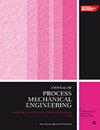Performance prediction and parametric study for annular radiator based on heat transfer unit efficiency and ELM-Sobol’ method
IF 2.2
4区 工程技术
Q2 ENGINEERING, MECHANICAL
Proceedings of the Institution of Mechanical Engineers, Part E: Journal of Process Mechanical Engineering
Pub Date : 2024-07-26
DOI:10.1177/09544089241267140
引用次数: 0
Abstract
One performance prediction method for an annular radiator that is a one neoteric heat exchanger is improved through using heat transfer unit efficiency to give consideration to both computational efficiency and accuracy, which can realize heat transfer capacity and air-side pressure drop calculation. Only one set of heat transfer unit simulation data is needed in the improved method, which can improve calculation efficiency by keeping a low numerical simulation workload. Compared with experimental data, the errors of heat transfer capacity are 2.20∼12.94% with an average deviation of 7.40%, and the errors of air-side pressure drop are 2.06∼4.75% with an average deviation of 3.19%. Based on the proposed performance prediction method, the influences of the number of fins in the axial direction (NFAD), number of fins in the circumferential direction (NFCD), and fin height (FH) on heat transfer capacity, air-side pressure drop, and weight are analyzed. An extreme learning machine (ELM) model is constructed to replace the proposed performance prediction method to calculate design indices in the Sobol’ method. Thus, the ELM-Sobol’ method is proposed to study the contribution degrees of the three configuration parameters on the three design indices. It indicates that whether the interaction between factors is considered or not, heat transfer capacity is the most sensitive to changes in FH, followed by NFCD and NFAD. The influences of NFCD on air-side pressure drop and weight are both the strongest, followed by FH and NFAD. Hence, when considering heat transfer capacity, air-side pressure drop, and weight simultaneously, NFCD and FH are suggested to be prioritized for adjustment among these configuration parameters. This research can provide valuable new thinking for heat exchanger design.基于传热单元效率和 ELM-Sobol'方法的环形散热器性能预测和参数研究
通过利用传热单元效率,对一种新热交换器环形散热器的性能预测方法进行了改进,兼顾了计算效率和精度,可实现传热能力和空气侧压降计算。改进方法只需一组传热单元模拟数据,数值模拟工作量小,提高了计算效率。与实验数据相比,传热能力误差为 2.20∼12.94%,平均偏差为 7.40%;空气侧压降误差为 2.06∼4.75%,平均偏差为 3.19%。基于所提出的性能预测方法,分析了轴向翅片数量(NFAD)、圆周翅片数量(NFCD)和翅片高度(FH)对传热能力、气侧压降和重量的影响。构建了一个极端学习机(ELM)模型,以取代所提出的性能预测方法,计算 Sobol'方法中的设计指数。因此,提出了 ELM-Sobol'方法来研究三个配置参数对三个设计指数的贡献程度。结果表明,无论是否考虑各因素之间的相互作用,传热能力对 FH 的变化最为敏感,其次是 NFCD 和 NFAD。NFCD 对空气侧压降和重量的影响最大,其次是 FH 和 NFAD。因此,在同时考虑传热能力、气侧压降和重量时,建议优先调整 NFCD 和 FH 这两个配置参数。这项研究可为换热器设计提供有价值的新思路。
本文章由计算机程序翻译,如有差异,请以英文原文为准。
求助全文
约1分钟内获得全文
求助全文
来源期刊
CiteScore
3.80
自引率
16.70%
发文量
370
审稿时长
6 months
期刊介绍:
The Journal of Process Mechanical Engineering publishes high-quality, peer-reviewed papers covering a broad area of mechanical engineering activities associated with the design and operation of process equipment.

 求助内容:
求助内容: 应助结果提醒方式:
应助结果提醒方式:


